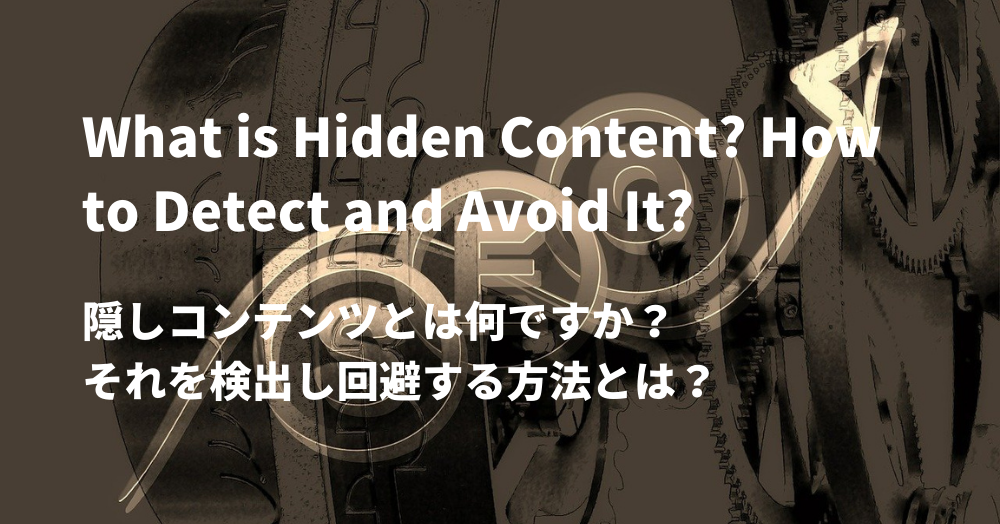隠しコンテンツとは、Webサイトのソーステキストから読み取れるが、Webサイトの訪問者には見えないコンテンツやリンクのことです。コンテンツを隠す目的は、ウェブサイトの使いやすさを制限すること(テキストデザート)ではなく、検索エンジンに関連するコンテンツを提供することです。キーワードによって強化され、隠されたテキストは、オーガニック検索結果の結果にポジティブな影響を与えることを目的としています。コンテンツを隠すことは、Googleウェブマスターガイドラインによると、操作とみなされ、ブラックハットSEOに分類されます。
1990年代半ば、ウェブマスターは検索結果でいくつかの「トリック」を使って比較的早く自分のページを上位にすることができた。隠しコンテンツもその一部だった。キーワードを含むテキストの一部を単純に蓄積し、例えば、ユーザーの目には白い背景に白い文字色で、ロボットには見えないように目立たなくさせる。当時、検索エンジンのロボットは、このテキストと他の目に見える部分をまだ区別することができなかったのだ。しかし、現在では、ロボットは、この文字や他の隠しコンテンツを容易に認識できる程度に発達している。また、隠しコンテンツはクローキングのサブタイプである。
隠しコンテンツの実用的な実装
実際には、隠しコンテンツはさまざまな形で現れる可能性があります。最も一般的に発生するものを以下に詳しく説明します。
- フォントサイズの操作:CSSを利用して、隠しテキストのサイズを “0 “にすることで、ユーザーから認識されなくする。
- 文字色の操作:文字色を背景色に合わせることで、ユーザーからは見えなくなってしまう。これは、CSSを使うか、spanタグとそれぞれのcolorコマンドで解決できる。
- divコンテナの非表示:CSSの「visibility: hidden」または「display: none」でdivコンテナを隠すことで、フロントエンドからテキストブロック全体を削除することができる。
- 画像の後ろに文字:既存のテキストに画像を重ねることも、隠しコンテンツの一種である。
- 隠しリンク:隠しリンクも隠しコンテンツの一部である。例えば、ハイフンやピリオドなどの特殊文字のリンクは、ネガティブに分類される。
フロントエンドにテキストが表示されなくても、ソーステキストにコンテンツが表示されていれば、検索エンジンに読み込まれる可能性があるのである。
検索エンジン最適化(SEO)
検索エンジンがまだ黎明期であった1990年代頃、検索エンジン最適化はまだ非常に簡単だった。ウェブマスターは、簡単な方法ですぐにランキングの成功を収めることができたのである。試行錯誤の末にたどり着いたのが、隠しコンテンツの利用だった。このコンテンツは、ランキングにプラスの影響を与えるために、キーワードで特別に強化されていた。さまざまな検索語を上位表示させるために、キーワードの詰め込みが隠しテキストに使用されることは珍しくなかった。
BMWのような大手ブランドでさえ、自社のWebサイトの検索可能性を高めるためにこの施策を利用したのである。(出典:https://www.cnet.com/news/google-blacklists-bmw-de/)。
以前は、クローラーは隠しコンテンツと可視コンテンツを区別することはできなかった。しかし今日までの間にこれは変更された。Googlebotは完全なWebサイトをレンダリングできるようになったため、ソーステキストと配信されたWebサイトの違いを認識できるようになったのである。
危険と罰
すべての検索エンジンは、ガイドラインで隠しコンテンツの使用を禁止している(Googleウェブマスターガイドラインへのリンク)。これを怠ると、ペナルティを受ける可能性がある。個々のサブページまたはドメイン全体がランキングで評価が落ちるか、あるいはドメイン全体がインデックスから削除される可能性があります。今日の世界では、隠しコンテンツはもはやSEO対策に使うべきではない。
リンクやテキストを隠すことは、Google、Yahoo、Bingなどの検索エンジン運営会社のウェブマスターガイドラインに違反することになる。例えばGoogleの場合、「Hidden Text and Hidden Links」というタイトルで非常に具体的なガイドラインがある。結局のところ、この手順は検索結果の操作に他ならず、したがってブラックハットSEOの領域に該当する。
ウェブサイト上のコンテンツを隠すと、ペナルティを受ける可能性がある。これは1つのページに影響することもあるが、検索エンジンオペレータがウェブサイト全体をインデックスから除外することもある。
Googleと他検索エンジンの検索アルゴリズムは絶えず改善されており、あらゆる種類の隠されたコンテンツが常によりよく認識されるようになっている。したがって、ランキングに影響を与えるためにこの方法を使用することはお勧めできない。
隠しコンテンツでも許可されているもの
またGoogleウェブマスターガイドラインによれば、隠しコンテンツは偽装ではないとの例外規定もある。
- 写真のAlt属性:画像にalt属性を付けて追加することが可能。Alt属性は画像についてさらに説明的な情報を提供するために使用することができる。
- JavaScriptのNoscript:NoScriptタグを使用すると、JavaScriptを使用しないユーザーにも同じ情報を提供することができる。テキストベースのブラウザ(JavaScriptなし)の例として、Lynxがある。
- 動画:Googleはウェブマスターガイドラインで、HTMLコードにテキストを追加(description)することは問題ないと書いている。また、ビデオのトランスクリプトを提供することも可能。
原則として、画像、動画、Javascriptなどのコンテンツを説明する追加情報は、隠しコンテンツとして分類されないため、ガイドラインに準拠している。
この形態では、隠しコンテンツは許可されるだけでなく、明示的に要求されます。
さらに、ホワイトハットSEOの形式による隠しコンテンツは、ページのデザインに悪影響を与えないように使用することができる。これらの例ではコンテンツは実際には隠されていないが、Webページのデザインとインタラクティブ性のデザインのために表示されていない。これは、たとえば次のように解決できる。
- 特定のインタラクションの後に、ウェブページの一部のセクションを表示すること。
- キーワードを配置するためにキャプションを使用する。
- ユーザーがカーソルを置いたりクリックしたりした後に、いくつかのコンテンツを表示する。
- テキストを展開したり折りたたんだりするボタン。
隠しコンテンツとホリスティックSEOについて最後に思うこと
隠しコンテンツは古いブラックハットSEO手法であるが、それでも2020年には隠しコンテンツを使用して関連性を高め、ランキングを上げるWebサイトがいくつかある。場合によっては業界や戦略によってもランキングが上げることが可能なのだ。隠しコンテンツはクローキングのサブタイプである。ジャパニーズキーワードハックなど、クローキングにはさまざまな方法がある。ホリスティックSEOは、コーディングとマーケティングのスキルのおかげで、ブラックハットのテクニックを使用する必要がない。しかし、ブラックハットのテクニックを知ることは、SEOに広い視野を与え、顧客を守る方法、ブラックハットのテクニックを使う競合に勝つ方法を教えてくれるのである。
2020年、検索エンジンは「不確実性の原則」を採用しているため、悪質な隠しコンテンツと通常の隠しコンテンツ(特定のインタラクションの中でデザインやUXのためにコンテンツを隠すこと)の差は薄い。SEO対策によっては、この薄い差を利用したブラックハット的な手法で優位に立てることもある。ホリスティックSEOは、このような状況を発見した場合、Googleに報告するとともに、検索エンジンの挙動をより理解するためにウェブページを調査することができる。
当社の「隠しコンテンツガイドライン」は、時間経過とともに改善されていきます。
What is Hidden Content? How to Detect and Avoid It?
Hidden content refers to content or links that can be read from a website in the source text, but is not visible to the visitor of a website. The goal of hiding content is not to restrict the usability of a website (text deserts), but to offer the search engines relevant content. The text enriched and hidden by keyword s has the goal to positively influence the results in the organic search results. Hiding content counts as manipulation according to Google Webmaster guidelines and is classified as Black Hat SEO.
In the mid-1990s, a webmaster was able to get his page forward relatively quickly with a few “tricks” in the search results. Hidden content was also part of this: simply accumulate a section of text with keywords and make it disappear, for example, with white text color on a white background for the user’s eye, but not for the robot. At that time, search engine robots were not yet able to distinguish this text from other visible parts of the text. Nowadays, however, the robots are developed to such an extent that they can easily recognize this and other hidden content. Also, hidden content is a sub-type of Cloaking.
PRACTICAL IMPLEMENTATION OF HIDDEN CONTENT
In practice, hidden content can appear in different forms. The most common occurrences are explained in more detail below:
・Manipulation of the font-size: Using CSS, the hidden text is set to the size “0” and is therefore no longer recognizable to the user.・Manipulation of the font color: By adjusting the font color to the color of the background, it is no longer visible to the user. This can either be solved using CSS or in the span tag and the respective color command.
・Hiding div containers: By hiding div containers using CSS “visibility: hidden” or “display: none”, entire text blocks can be removed from the front end.
・Text behind images: Another variant of hidden content is to overlay existing text with an image.
・Hidden links: Hidden links are also part of hidden content. For example, the linking of special characters such as hyphens or periods is classified as negative.
As long as content appears in the source text, it can be read by search engines, even if no text is visible in the front end.
SEARCH ENGINE OPTIMIZATION (SEO)
When search engines were still in their infancy around the 1990s, search engine optimization was still very easy. Webmasters were able to achieve quick ranking successes with simple means. A tried and tested means was the use of hidden content. This content was specifically enriched with keywords in order to positively influence the ranking. It was not uncommon for keyword stuffing to be used in the hidden texts in order to rank a wide range of search terms.
Even big brands like BMW used the measures to increase the findability of their website (Source: https://www.cnet.com/news/google-blacklists-bmw-de/).
In the past, crawlers could not distinguish between hidden and visible content. This has changed in the meantime. The Googlebot is now able to render a complete website and thus recognize differences between the source text and the delivered website.
DANGERS AND PUNISHMENTS
All search engines prohibit the use of hidden content in their guidelines (link to the Google Webmaster guidelines). Failure to do so may result in a penalty. Individual subpages or the complete domain can either be devalued in the ranking or even the entire domain can be removed from the index. In today’s world, hidden content should no longer be used in an SEO strategy.
Hiding links and or text violates the webmaster guidelines of search engine operators such as Google, Yahoo, and Bing. From Google, for example, there is a very specific guideline under the title “Hidden Text and Hidden Links”. After all, the procedure is nothing more than a manipulation of the search results and thus falls under the area of Black Hat SEO.
If you hide content on your website, this can result in a penalty. This can affect a single page, but can also result in the search engine operator excluding the entire website from the index.
The search algorithms from Google and Co. are constantly being improved so that the hidden content of any kind is always recognized better. It is therefore not advisable to use this method to influence the ranking.
HIDDEN CONTENT IS ALLOWED
There are also exceptions to hidden content, which are not a deception according to the Google Webmaster guidelines.
・Alt attribute in pictures: It is allowed to add pictures with the alt attribute. The Alt attribute can be used to provide further, descriptive information about the image.・Noscript in JavaScript: The NoScript tag enables you to provide the same information to users without JavaScript. An example of a text-based browser (without JavaScript) is Lynx.
・Videos: Google writes in the webmaster guidelines that adding text in the HTML code (description) is not a problem. It is also possible to provide a transcript of the video.
In principle, additional information that explains content such as images, videos, or Javascript is not classified as hidden content and is therefore in compliance with guidelines.
In this form, the hidden content is not only allowed, but expressly requested.
Furthermore, hidden content in the form of White Hat SEO can be used so as not to negatively influence the design of a page. In these examples, the content is actually not hidden but also not visible because of the web page’s design and interactivity design. This can be solved, for example:
・Showing the some sections of the web page after certain interactions・Use captions for placing keywords
・Show some content after the user’s hover or click actions
・Buttons to expand and collapse texts
引用:What is Hidden Content? How to Detect and Avoid It?|Holistic SEO
Last Thoughts on Hidden Content and Holistic SEO
Hidden content is an old Black Hat SEO Technique but still, in 2020, there are some websites that use hidden content to create relevancy and gain ranking. In some cases, industries, and strategies it can also boost rankings. Hidden Content is a sub-kind of Cloaking. There are lots of different methods for Cloaking such as Japenese Keyword Hack. A Holistic SEO doesn’t need to use Black Hat Techniques thanks to his/her Coding and Marketing Skills. But still, knowing Black Hat Techniques give a broader perspective to the SEOs and also it teaches how to protect the customers these kinds of acts and how to beat competitors who use Black Hat Techniques.
In 2020, since the Search Engines embraces the Uncertainty Principles, bad hidden content and normally hidden content (hiding content for design and UX within certain interactions) have thin differences. In some SEO Strategies, these kinds of black hat techniques can create advantages by exploiting this thin difference line. When a Holistic SEO sees this kind of situation, he/she can report the situation to Google and also examine the web page to understand Search Engines’ behaviors better.
Our Hidden Content Guideline will continue to improve by time.


コメントを残す